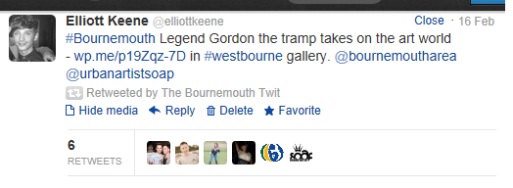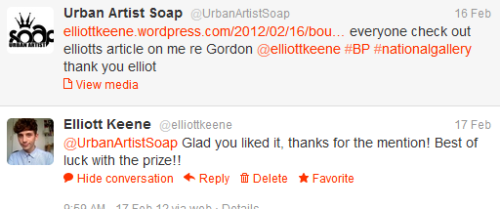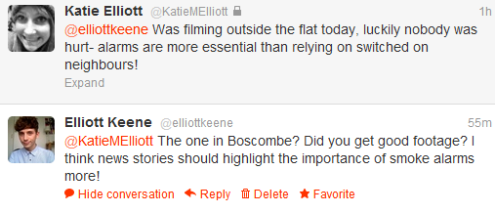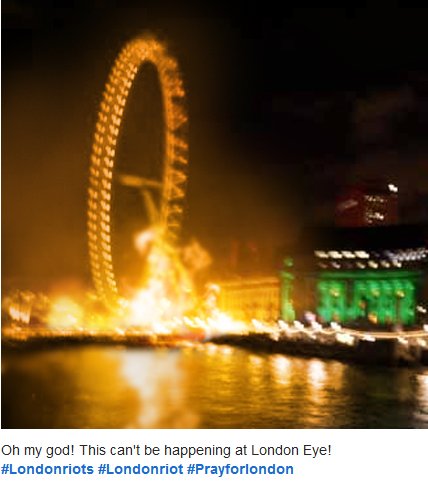Archive for the ‘Social Media’ Category
Transcending The Boundaries Of News
Posted by: Elliott Keene on: January 19, 2013
Why today’s fragmented media landscape is forcing us to question the relevance of professional journalists..
It was the middle of the night in Abbottabad, Pakistan. I.T consultant Sohaib Athar was sat at his laptop to begin a long night of work as his family slept. But something was distracting Mr Athar. “Helicopter hovering above Abbottabad at 1AM (is a rare event)” he said to several hundred followers on his Twitter account. Little did he know he had just sent the first report of a piece of American history, the killing of the world’s most wanted terrorist.
After hearing official confirmation of Osama Bin Laden’s death, he realised that he had unwittingly live-tweeted the raid, was inundated with messages and saw his follower count jump to over 50,000.

On the other side of the world in Washington DC, preparations made by producers at Al Jazeera English for the debut episode of their new show The Stream were disrupted by news of Bin Laden’s death. In a last minute schedule shake up, Mr Athar was reached via Twitter and interviewed on Skype during the live show, bringing a whole new meaning to the idea of a ‘world exclusive’.
In fact, the entire point of The Stream is to challenge the rulebook of conventional broadcasting by bringing an online community of social media users together and reporting on the unreported. Using Skype to access guests in a wide variety of locations and bring experts into the live discussions is just one of the ways the programme is demonstrating the advantages of utilizing online platforms and is “becoming a centre of excellence at Al Jazeera”, says Malika Bilal, digital producer and co-host of the show.
Placing social media at the heart of its editorial processes, The Stream brings debates to life with the #AJStream tag and also recognises the value of newcomers Google Plus and Pinterest to aggregate content. It has since received a Royal Television Society Award for its innovative news delivery and most recently a Webby Award which is to be presented to producers at a ceremony next week.
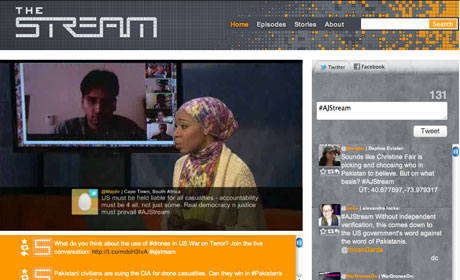
So, how are they getting it so right using these participatory tools where others are not? There’s no doubt that the open communications platforms embraced by The Stream have held a microphone up to the voices of those caught up in the Arab Spring uprisings. Capturing the brutal realities of the clashes and the raw emotions of liberated people in real-time, social media has never before played such a “pivotal role in supporting news production and diffusion”, claims academic Chei Sian Lee in her latest article.
Alongside The Stream and content sharing sites such as YouTube and Flickr, emerging social media aggregator services such as Storify and Storyful recognise the significance of user-generated content by allowing amateurs to tell the news themselves.
“It’s forcing journalists to get their content into as many places as possible and to prove their value” Global Advocate at Storyful.com, Claire Wardle told me. “Audiences can now choose what they consume”.
News organisations are becoming increasingly aware of this and attempting to keep up with fast paced and dynamic social media tools. Journalists are encouraging audiences to access them through a multitude of channels, from mobile applications and tablet devices to videos and podcasts. Providing live update bulletins on an unfolding story, such as a court case or riot break out, has also proved effective. Undeniably, one of the greatest effects social media has had on journalism is stimulating good old fashioned discussion, a virtual discourse within and between the agenda setters and the people.
Journalism professor Matt Hinckley has claimed the adoption of social media can improve not only the relations with readers, but the quality of concise reporting. “Twitter can help the reporter recognise the edge of a story and edit it to 140 characters, YouTube allows more coverage of stories that TV news often omits and Facebook provides another means for reporters to connect with newsmakers” Hinckley told OurBlook.com.
A professional journalist of today must acknowledge the possibilities of the digital sphere to source news, access witnesses and follow developments. If they are to maintain jurisdiction against the growing impact of social media, news rooms should diverge from their innate conservatism that preaches a one-way mode of communication and what Donald Matheson slates as a “rather static core set of news practices”.
“Twitter is a fantastic way of adding value to existing stories” says Jason Mills, ITV Web Development Editor. ITV News online recently adopted a live stream as part of their drastic redesign in March this year, which visibly takes inspiration from social media formats.
“Digital audiences are getting increasingly used to finding out things as they happen. From Twitter-falls to Facebook timelines, real time is an accepted way of storytelling” Mills explains. As a professional who previously worked with the BBC and Sky, Mills flags up that traditional journalists are giving recognition to a range of sources and beginning to open their gates to social media. “It allows us to curate news from different sources and offer people more than just our own journalism”.
The immediacy at which information reaches audiences, however, is yet another area where social media is hammering tradition. It has become common case for everyday people to break news stories on Twitter and create a buzz before mainstream media have had a chance to confirm reports. If Whitney Houston’s death can initiate over 2.5 million tweets in the hour that it took the Associated Press to confirm her passing, then surely the need for journalists is diminishing.
Not at all, says Mills. “We act as filters for what really is news. Sifting all the information out there to discover what the real story is” he tells me. In the event of the London riots last summer, ITV News’ twitter coverage primarily consisted of debunking rumours and fact checking. “People criticise old media for being slow. It’s necessarily being slow. It’s making sure it’s accurate” he says.
As Pew Internet & American Life Project’s 2010 report concluded, online news has largely become a shared social experience and constant mobile connectivity has turned news awareness “into an anytime, anywhere affair”. Yet our obsession with speed has accelerated the pressure to be first, often at the expense of being correct. Whether it’s tigers walking the streets of London or yet another celebrity Twitter death, social media has poisoned susceptible audiences and journalists with a dose of misinformation in many cases.
Perhaps the risk of inaccurate reports and hoaxes undermine the credibility of social media as a news source and simply reiterate the responsibilities of the journalist to guard the facts. Reuters set the trend for the BBC and Sky by introducing a strict social media policy in 2010 that prohibited their journalists to break news via Twitter, insisting staff have their posts double checked and remain suspicious of unverified online sources.
Ultimately, then, social media has irrevocably changed journalism from two key standpoints. While we expect mainstream media to get more interactive, portable and socially integrated, we also expect them to stand up amongst the sea of voices in public communication. “It adds two way interaction to journalism” says Mills, “but it doesn’t change journalistic values”.
Today, Sohaib Athar can make the news. People are able to “write the first draft of history” as digital media columnist Dan Gillmor puts it. Events such as the Arab Spring could not have been told were it not for social media platforms, yet claims of revolutionary change in news must not be overstated. Social media powers a faster distribution channel for news and adds multiple sources for fact gathering, but only a journalist can do the fact checking.
For Jason Mills, it’s just another tool to add to how journalists operate, and nothing more. “Whatever technological advances have been made and whatever is still to come, journalism in its purest form still remains the same” he insists.
Social Media Engagement: A Self Reflection
Posted by: Elliott Keene on: May 4, 2012
During the past four months I have experienced Twitter as a fundamental communications tool in today’s online media environment, as a journalist, a blogger, a reader and a member of the local community. Initially I was surprised by the interactivity and immediacy of information diffusion across the platform, particularly with users that I did not know. My blog posts have been tweeted as ‘top stories’ numerous times and an interest in my writing has brought many new followers.
The hash tag is the site’s most resourceful feature, providing streams of searchable content and instant discussions around a certain debate, news event or place. By frequently using the tag #Bournemouth and relevant @mentions, I was able to reach many people through sharing my blog posts and having conversations with them over Twitter – as the examples below demonstrate.
The second blog post I had written with a local angle about a portrait of ‘Gordon the Tramp’ in the National Portrait Prize showed just how powerful Twitter can be for journalists, and potentially citizen journalists too. A significant amount of ‘Retweets’ within several hours of publication and further sharing over Facebook drew large numbers of readers to my blog, as my following post detailed (https://elliottkeene.wordpress.com/2012/02/26/the-power-of-twitter/). I feel this blog post in particular is important, as I learnt how my observation that ‘everyone is a journalist’ in the digital age proved seemingly correct.
As I continued to blog, I allowed myself to be more creative with my writing, use of images and involvement with Twitter. I attempted to interact with my followers by asking them questions, using key hash tags and directly linking both my posts and online news stories (see below).
I tweeted about stories from national newspapers and other news sites frequently, often through retweeting or linking my followers to stories I came across that were of relevance to my own blog posts. Doing this brings a level of continuity and coherence with Twitter posts, in an effort to not simply post randomly but to engage with Twitter users over a topical subject.
My interaction with followers proved to be insightful as several provoked discussion over the stories I distributed (see below). For a professional journalist, this allows for a two-way communication with their audience and an effective way to source further information from the public. For a citizen journalist or blogger such as myself, it exemplifies the possibilities of online discourse with virtual communities and the potential for more collaborative forms of journalism in the future.
Finally, my proudest moment during my experience as a journalist – getting my published feature in the Bournemouth Rock over a double-page spread seen by the subject of the story and shared across Twitter!
A Mass Defiance Against Mass Media
Posted by: Elliott Keene on: May 3, 2012
Last month (April 2012) the latest mobile application to embrace citizen journalism was launched in the Middle East, placing the power of news gathering and disseminating roles into the hands of those on the ground. ‘Signal‘ was inspired by the Arab Spring uprisings, and more specifically, the citizens involved in the chaos who are striving to report on the unreported.
The creator behind the application, Mark Malkoun, claims the tool allows its users to geo-tag their content to organise it by location and filters breaking stories by their importance using a voting system, giving total jurisdiction to the audience and defying mass media control – as Malkoun notes “traditional news is centralised and can be slow or biased”.
Biased, I would say, is an understatement here. Both foreign and Middle Eastern journalists suffer severe restrictions. Many are being banned from the streets, imprisoned, or in extreme cases killed – as my previous post on British reporter Marie Colvin’s tragic death exemplifies. Social media has played an essential part in breaking the news across the world – but no where else has it proved to be so fundamental to the truth and to freedom. It’s pivotal role in supporting the news production without political constraints during the Arab Spring provides alternative narratives to that presented by the heavily controlled corporate media.
Citizen journalism collective Mosireen (meaning ‘Egyptians determined’) had the most viewed worldwide non-profit channel on YouTube in January this year (see here). During the brutalities in Egypt that surround them, the group provide independent coverage of events they see as untruthfully reported by the mass media – often getting seriously injured in their attempts to do so. (See video below from Mosireen’s YouTube channel).
I recently came across the book “Tweets from Tahrir” (see here), which documents the successful uprisings in Egypt by telling the narrative of the President Mubarak demonstrations through the Twitter updates of those involved. Through the cries of both violence and liberation, Tweets from Tahrir presents a rich historical archive of the real reactions captured on the micro-blogging site as the events unfolded.

Connecting citizens during the revolution in a way that requires no professional reportage at all is testimony to a mass resistance against authority. Simon Cottle supports the current shift in power in his study by giving credit to social media platforms for “communicating, coordinating and channelling this rising tide of opposition and managing to bypass state controlled national media”. (See Cottle’s research here)
But there’s more – the media are not the only barrier to transparent reporting in the Middle East. In response to high levels of Twitter activity that inflamed the revolt, Egyptian government blocked social media sites. Many managed to bypass the restrictions using proxy servers to share their content with sites such as Flickr and YouTube, which demonstrates the sheer passion of those who were once news consumers as transformed news activists.
As internet access becomes more widely available around the world on just about any medium – tools such as ‘Signal’ are amplifying citizen’s voices in completely new ways. Consequently, mainstream media are beginning to take note…but you have to wonder whether its because they don’t want to be left completely out of the loop. It seems unlikely that the mainstream media will effectively become the outsiders, but organisations have every reason to worry as their ‘audiences’ recognise that in intense circumstances citizens are the only direct source of truth.
Misinformation in the Twittersphere
Posted by: Elliott Keene on: April 8, 2012
- In: Journalism | Portfolio | Social Media
- 1 Comment
The power of the Retweet – would you say it’s a help or a hazard for journalism?
Using social media as a news source is becoming increasingly apparent, but increasingly dangerous too. The social nature of the web is revolutionising how stories are broken and distributed, yet all too often speed is being valued over accuracy.

Unlike traditional media, social media platforms bypass censors and can place false information into the public domain. Any regular Twitter user probably remembers the last time they saw a RIP next to a celebrity’s name as a trending topic, only to find it was a hoax.
Twitter is becoming a social media assassin – reporting on famous deaths from Nelson Mandela to Britney Spears. Those that kick start these rumours are probably just up for a bit of fun, but it can have damaging consequences.
From riots to RIP’s, a need for speed is putting facts in jeopardy.
The recent death of Whitney Houston serves as an example of just how fast breaking news can reach millions across the internet without a single confirmed news report. A whopping 2.5 million tweets related to Houston’s death were counted within an hour alone – before the Associated Press could even confirm her passing. However, Twitter’s reputation for hoaxes left many doubting any truth behind the claims of Houston’s death.
Reporting threats in inaccurate locations was rife when the London riots began to spark apparent uprisings across the UK. People throughout the country were left terrified as false rumours of rioting in their local town broke on social media. One image that surfaced on Twitter had even been digitally edited with Photoshop to depict a blaze attacking the London Eye (see below) which exemplifies such deliberate attempts to corrupt the use of Twitter as a news source.
But it’s not just audiences – journalists too are taking to the platform to distribute news, give commentary and interact with their readers. One in particular decided to experiment by purposely spreading false stories. Mike Wise, the Washington Post reporter, was suspended after taking the company’s reputation too lightly by fabricating material through a user account but he demonstrated how other bloggers and journalists will republish unproven rumours.
Journalists told to ‘be suspicious’ of all information online
These cases are a startling reminder of the weakness social media can have as a news source, at a time when media organisations are tightening the reigns on journalists as a consequence. International news corporation Reuters introduced their social media policy in 2010 to prohibit their staff from breaking news through Twitter.
The policy states that staff must get tweets double-checked and approved by managers before posting anything. The handbook for journalists working under the organisation clearly states “do not use news until you are certain of its authenticity” and to be suspicious of all information online that “is not sourced in a way that you can verify”. (The full guide can be accessed here- http://tinyurl.com/ctquehq)
Clearly Reuters is acknowledging that these platforms pose a threat to the traditional news cycle by breaking news first, but are the attempts to control social media use making their content less relevant to audiences? Are they in fact trying to maintain professional standards in an era that no longer values accuracy over immediacy?
Using Twitter for news means journalists are vital, not redundant.
Perhaps, though, the rise of misinformation on Twitter means it is increasingly vital for journalists to filter information and guard their role as the gatekeeper. “Twitter simply reiterates the essential role of journalists in sifting through the rumour mill” writes journalist Hermon Manson (http://tinyurl.com/866sv4h).
Whichever way you look at it, fabricated news is a manipulation of the social power the internet has. Twitter is uncurated as of yet and this makes it easy to pass along fiction as fact.
The Power of Twitter
Posted by: Elliott Keene on: February 26, 2012
- In: Journalism | Portfolio | Social Media
- 1 Comment
How the ultimate media platform took me by surprise.

Some may say the influence of the ‘Twitterverse’ is exaggerated, over-hyped and glamorised. I agree; it’s endorsement by every brand and celebrity figure under the sun is perhaps a little overbearing – especially for those who haven’t caught onto it.
As a journalist, though, the platform is the ultimate connectivity tool for the twenty first century. 140 characters with interwoven tags and mentions can be empowering for everyone with access, allowing us to become more connected with the growing possibilities of ‘web 2.0‘ that surround us.
It is hardly a revolutionary statement to say that Twitter (alongside Facebook, YouTube, Flickr, Instagram, LinkedIn, etc.) has changed the nature of journalism forever. Professionals and rising amateurs can provide up-to-the-second information on the latest happenings and trends around the globe. Now our days, personal interviews and contact information can be accessed in just a moment over the web.
Journalists are finding sources, the right people and valuable material through their connected Twitter feeds and lists. Furthermore, news can spread at speed never seen before. You simply can’t come across anything online without seeing a share, comment or rate button – it seems the interactive dynamics of the internet are beginning to be used to their advantage.
After my personal experience of this, I decided to use my own work as an example of just how powerful Twitter can be…
This is my original tweet on the afternoon of February 16th. After publishing a story I sourced and wrote up onto my blog about a local artist, I tweeted about it with the tags #Bournemouth and #Westbourne to make the information searchable to anyone looking up the areas. Secondly, I directly @ mentioned a Bournemouth news twitter account and the artist himself, the Twitter username ‘urbanartistsoap’. Well, this was just me being a good journalism student. I had not prepared for what came next.
The post was retweeted 6 times in just a few hours by the artist, friends and a few unknown people. The interesting thing is, these unknown people, and those who follow them, all ended up following me because of one tweet. (See below).
As my story began to spread across Twitter, it also appeared on other social networks like Facebook and community-based blog sites (see below). The integration of Twitter on Facebook amplifies posts across the two sites, reaching wider audiences simultaneously.
By this point I was surprised at just how suddenly the story rapidly spread and the amount of online readers that were interested in the piece. The artist himself was very pleased with it and urged his many followers to follow me, before offering me some work experience – yes, in a tweet! Whilst this opportunity came out of the blue, none of it would have happened had I not tweeted my article with the right @mentions and #hashtags to get it out there.
My blog statistics the following day showed that it boosted my page views significantly too..

Surely this demonstrates the incredible capabilities of Twitter, as an information distributor with a whole lot of clout. It is no wonder that journalists are reconsidering their traditional roles and newsrooms are changing how they disseminate their news.
Engaging with where the audience are based rather than waiting for them to come to the news is the fundamental change of practice here. Journalists are now fighting not only a declining newspaper readership, but the diverse and social means of aggregating news content online too.
For the article in reference, see my previous post below.
Everyone is a Journalist
Posted by: Elliott Keene on: January 27, 2012
When was the last time you uploaded words or images instantly viewable to hundreds of others online? In a world that is increasingly photographed, filmed, reported and blogged about, today’s communication tools have the power to influence like never before.
Whilst television and radio media have incorporated audience’s views and contributions through various interactive platforms, it is the internet that truly embraces the participatory space. Indeed it could be argued that traditional Journalism is loosing it’s relevance in a fragmented media environment, but surely the changing practices and growth of social media only enhance the role of the professionals, to set the news agenda and filter the vast number of tweets, videos and images into what counts as newsworthy.

For my 10,000 word dissertation I am studying these comparisons between established news gathering/distributing techniques and the role of citizen journalists in breaking news events. As a current topic, it is something that changes rapidly and will continue to shape the future of our news. The debate of the professional vs. the amateur is ongoing, but the values of trust, accuracy and fairness remain. Alongside my research, I am studying a News & Journalism unit in the final term of my degree – to explore elements of news & feature writing, patch reporting and online engagement.
In the first of these sessions, my tutor asked us inquisitively; why Journalism?
There will always be a part of me that wants to write as if I am a journalist. I was 15 when I first set foot in a Newsroom, where I spent a week sat at a desk with a Windows 95 computer typing up what I thought were incredibly interesting local news stories. Looking back, I did learn a lot, but perhaps not quite what I had anticipated. I am simply far too much of a perfectionist to crack out hard news pieces, to commit to a deadline and answer to an editor. I just like to write.
In the coming weeks I will be put to the challenge, gathering stories from local communities and producing news content fit for publication, but I am eager to try my hand at it once more. My outlook six years on is a different one – everyone can be a journalist, in theory. Equipt with mobile technology and socially connected platforms, citizen-produced content can spread fast.

The image above has become renowned by citizen journalist commentators, which was snapped on an iphone and tweeted by onlooker Janis Krum following the US Airways aircraft crash into the River Hudson. Now, I am no Janis Krum, and I certainly don’t expect a plane to fall from the sky and land in Bournemouth any time soon, but there is no denying we live in an age of undermining traditional media. I have the potential, much like everyone with the right tools, to establish myself as a citizen journalist. Whether known as grassroots reporting, user-generated-content or participatory news, whichever way you phrase it – the balance in power really is shifting towards the people.




